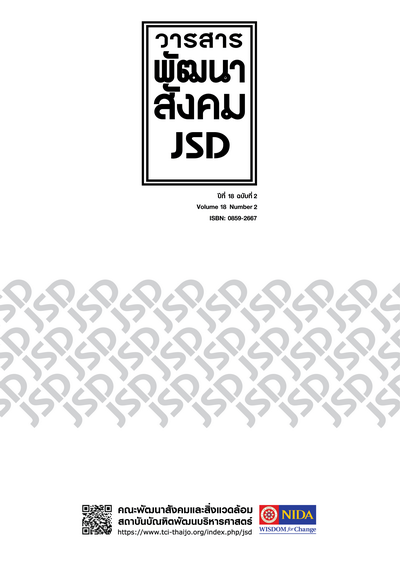ความสัมพันธ์เศรษฐกิจไทย-จีน ภายใต้การเปลี่ยนแปลงของเศรษฐกิจโลก
Main Article Content
Abstract
บทความชิ้นนี้ศึกษาความสัมพันธ์หุ้นส่วนเชิงยุทธศาสตร์ระหว่างประเทศไทยกับประเทศจีนโดยมีวัตถุประสงค์เพื่อ
(1) ศึกษาสถานการณ์ทางเศรษฐกิจของประเทศไทยและประเทศสมาชิกอาเซียน (2) ศึกษาสถานการณ์ทางเศรษฐกิจของจีน (3) ศึกษาประเด็นปัญหาเชิงยุทธศาสตร์ในสถานการณ์เศรษฐกิจชะลอตัวทั่วโลก (4) เสนอข้อเสนอแนะความร่วมมือเชิงยุทธศาสตร์ต่อรัฐบาลจีนและรัฐบาลไทย ผลของการศึกษาพบว่าทั้งประเทศไทยและประเทศจีนเผชิญสถานการณ์สภาวะปกติใหม่ (New Normal) ที่ทั้งสองประเทศเร่งหาทางปรับโครงสร้างเศรษฐกิจ ประเทศสมาชิกอาเซียนประสบปัญหาเหมือนประเทศไทย ประเทศจีนแม้แต่ประเทศต่าง ๆ ทั่วโลก ตามรายงานของสถาบันการบริหารการพัฒนาระหว่างประเทศ (International Institute for Management Development) เมื่อปี 2016 ว่าด้วยสถานการณ์เศรษฐกิจของจีนในขณะนี้ จีนกำลังเตรียมทำแผนพัฒนาเศรษฐกิจสังคมแห่งชาติฉบับที่ 13 ยุทธศาสตร์ของแผนฯ 13 คือผลักดันการพัฒนาเศรษฐกิจควบคู่ไปกับความมั่นคงของชาติ สาระสำคัญของแผนฯ 13 คือเปลี่ยนรูปแบบของการพัฒนาเศรษฐกิจ ปฏิรูประบบเศรษฐกิจเพื่อสอดคล้องสภาวะปกติใหม่ จีนจะผ่อนกฎระเบียบการควบคุมเงินตราต่างประเทศ พัฒนาอุตสาหกรรมที่เป็นมิตรต่อสิ่งแวดล้อม พัฒนาโครงสร้างพื้นฐานภายใต้ข้อริเริ่มหนึ่งแถบหนึ่งเส้นทาง (One Belt, One Road) การเชื่อมโยงระเบียงเศรษฐกิจตะวันออก-ตะวันตก ผลักดันความร่วมมือระหว่างจีนกับประเทศต่าง ๆ ตามเส้นทางสายไหมทางทะเลเพื่อผลประโยชน์ร่วมกัน ในขณะเดียวกันมีการเสริมสร้างความเข้มแข็งให้เศรษฐกิจภายในประเทศจีนเองด้วยยุทธศาสตร์ "Made in China 2025" ดังนั้น ข้อเสนอแนะสำหรับรัฐบาลไทยคือ (1) รัฐบาลไทยต้องสร้างความสัมพันธ์ทางด้านการค้า การลงทุนที่เข้มแข็งระหว่างภาครัฐและภาคเอกชน (2) รัฐบาลไทยต้องผลิตและส่งออกสินค้าสำหรับผู้บริโภคจีนมากขึ้นเพื่อเป็นการขยายการค้าการลงทุนระหว่างกันภายใต้ข้อริเริ่มหนึ่งแถบหนึ่งเส้นทาง กล่าวโดยสรุปการวิเคราะห์สถานการณ์การค้าการลงทุนและวิเคราะห์นโยบายระหว่างไทย-จีน จะเป็นประโยชน์ต่อการส่งเสริมพัฒนายุทธศาสตร์การพัฒนาของทั้งสองประเทศ ยุทธศาสตร์ต่อไปนี้จะเป็นยุทธศาสตร์พัฒนาความสัมพันธ์ทางเศรษฐกิจระหว่างไทย-จีน ยุทธศาสตร์ที่ 1 เพิ่มมูลค่าการค้าระหว่างไทย-จีน ด้วยการส่งเสริมการค้าที่เอื้อประโยชน์ซึ่งกันและกันและแก้ไขปัญหา อุปสรรคด้านการค้า ยุทธศาสตร์ที่ 2 สร้างมูลค่าเพิ่มของสินค้าและพัฒนาการค้ากับจีนด้วยสินค้าที่มีมูลค่าเพิ่มสูง เช่นแปรรูปสินค้าเกษตรกรรม เช่น ข้าว ยางพารา ผลไม้ เป็นต้น เพื่อลดปริมาณเสียดุลการค้ากับจีน ยุทธศาสตร์ที่ 3 ส่งเสริมการลงทุนระหว่างกันมากขึ้นเพื่อประโยชน์ร่วมกัน โดยใช้ความได้เปรียบจากทำเลที่ตั้งของประเทศไทยที่เป็นศูนย์กลางอาเซียน ยุทธศาสตร์ที่ 4 ยกระดับขีดความสามารถด้านการแข่งขันด้วยความร่วมมือทำวิจัยและพัฒนา (R & D) ยุทธศาสตร์ที่ 5 ทั้งไทยและจีนประสานนโยบายของทั้งสองประเทศ ประเทศไทยได้กำหนดนโยบายต่าง ๆ เช่น อุตสาหกรรม 4.0 รวมกลุ่ม (Super Cluster) หรือนโยบายส่งเสริมการลงทุนจากคณะกรรมการส่งเสริมการลงทุน เช่น นโยบายส่งเสริมการตั้งสำนักงานใหญ่ การตั้งศูนย์การค้าระหว่างประเทศ เป็นต้น ส่วนประเทศจีนก็กำหนดนโยบาย “Made in China 2025” และหนึ่งแถบหนึ่งเส้นทาง เป็นต้น
คำสำคัญ: หุ้นส่วนเชิงยุทธศาสตร์ สถานการณ์ทางเศรษฐกิจ สภาวะปกติใหม่ ผลิตที่จีน 2025 หนึ่งแถบหนึ่งเส้นทาง
Strategic Partnership on Economic Relations
This paper aimed to study the relationship between Thailand and China in terms of strategic partnership. The purposes were: 1) to study the facts on current economic situation in Thailand and ASEAN countries; 2) to study the facts on current economic situation in China; 3) to study the strategic problems negotiated with issues to be considered in the global slowing economy; and 4) to give strategic suggestions on Thailand and China’s economic cooperation to both Thai government and Chinese government. The study has found that Thailand and China were facing the current "New Normal” situation which both countries seek to accelerate restructuring to meet. ASEAN countries were facing the same situation as Thailand, China and all countries in the world as well. When considering the economic performance reported by International Institute for Management Development (IMD) in 2016, China prepared its national economic development plan under the name of "Strategic Plan and Five-Year Plan on the 13th China's New Normal". The importance of this strategic plan was to push economic development together with the creation of defense national security. The essence of the 13th national economic development plan was to focus on transforming the economic development pattern and adjusting on system compliance in accordance with the “New Normal” situation. The projects focused on major transportation along the roads, seacoast and river-coast under the name of “One Belt One Road”. Liberalization of foreign investments, green industry with low-carbon release and recycle, these strategies were created for China’s national mega database under the name of “Big Data”. Liberalization of the economy linked to economic corridor from east - west land, pushing other sea routes countries for cooperation, economic partnership for mutual benefit between China and foreign countries, were to make the local economies strengthening of industrial production with "Made in China 2025" and to open set prices regulations according to market system forces. Some recommendations for Thai government can be made as follow: 1) Thai government must strengthen ties in trade, investment stronger coordination between the government and the private sectors for more export. 2) Thai government must provide more products for Chinese consumers and set strategy for trade expansion and investment for support of the project “One Belt One Road”. In conclusion, a trade and investment situation analysis and policy analysis between Thailand and China will promote economic development strategy for both countries. The following strategies are strategic development for economic relationship between Thailand and China. Strategy 1.Increase the value of trade between Thailand and China by public relations strategy to promote mutual trade by promotion-boost trade with each other and tackle trade barrier problems. Strategy2.Use value-added products from Thailand for the trade deficit reduction with China by creating value-added production focusing on processing agricultural products such as rice, rubber, fruits and many more products. Strategy 3.Promote mutual investment between Thailand and China for mutual benefits. As for Thailand it has the best location as the center of ASEAN in encouraging Chinese enterprises to build production base in Thailand. Strategy 4.Build strategic partnership by collaborative Research and Development (R & D) for competition capabilities. Strategy 5.Open paths for Thailand and China investing together with the policy coordination. Thailand has policies and collective agreements, such as, industry 4.0, super cluster, and the Board of Investment (BOI) of Thailand investment promotion policies such as international trade center and international headquarters. China has policies such as, “Made in China 2025” and “One Belt One Road”.
Keywords: Strategic Partnership, Economic Situation, New Normal, Made in China 2025, One Belt One Road


